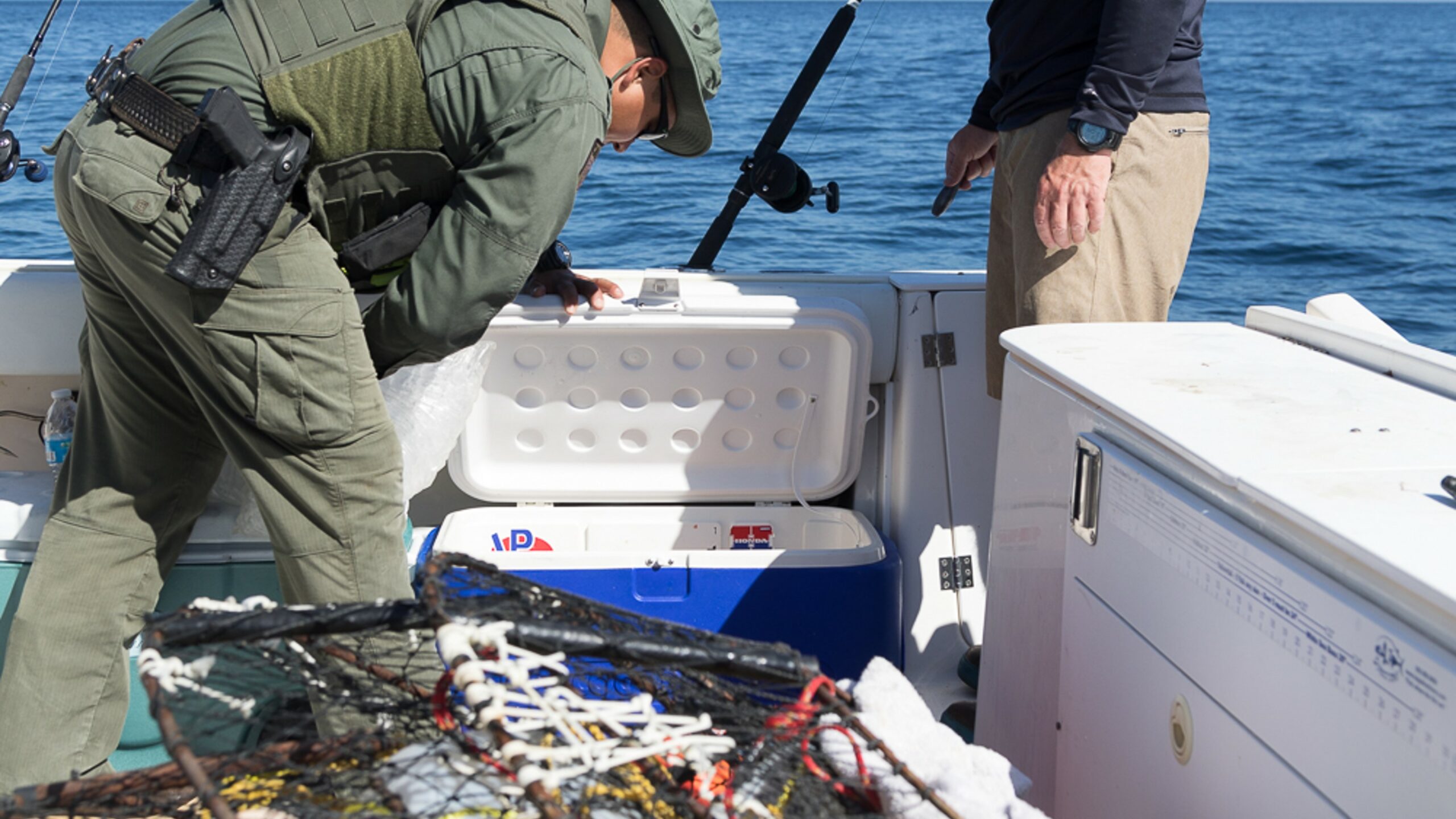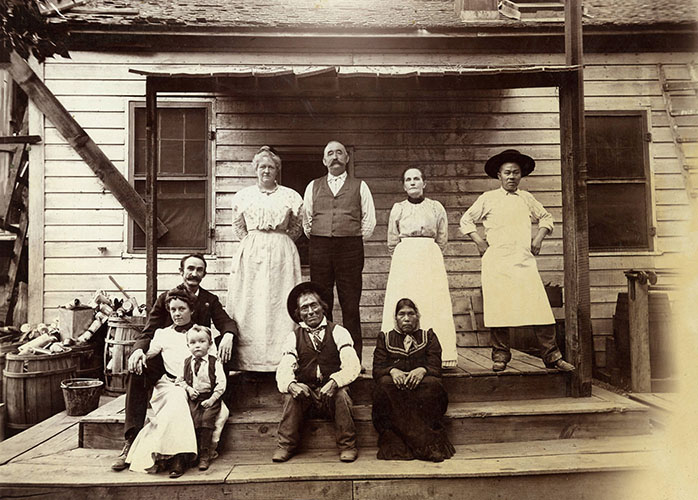
Lieutenant James Ober worked as a fish biologist with the California Department of Fish and Wildlife for a year before joining its Law Enforcement Division in 2009. “I enjoy interacting with hunters and fishers. Most of them have a great appreciation for the resources and want to protect them,” says Ober about being on patrol.
Ober belongs to the tradition of wildlife officers, both personally and professionally. His fifth great grandfather, Edwin H. Ober, was an officer and biologist during the early 20th century, making James the second wildlife officer in his family. Ober is also one of the tens of thousands of officers who have worked to protect the natural resources of the San Francisco Bay since 1871.
This year marks the sesquicentennial of the California Department of Fish and Wildlife (CDFW). The state of California appointed its first Board of Fish Commissioners (today’s Fish and Game Commission) in 1870, making it the first wildlife conservation agency in the United States. The following year, the Commission hired two wildlife officers (traditionally called deputies or wardens) to support the laws enacted to protect and preserve the fish in California’s waters. “We are the longest, continuously serving statewide peace officers in California, preceding California Highway Patrol by 58 years,” says Patrick Foy, captain of CDFW’s Law Enforcement Division.

Ober works in CDFW’s North Coast District, and his beat of San Francisco and San Mateo counties includes the San Francisco Bay. He and his team patrol the shoreline and piers by vehicle five or six days a week, and about twice a month conduct compliance checks on the Bay in a 26-foot, inflatable Zodiac Hurricane or an 18-foot Boston Whaler Super Sport. Whether on land or water, their job is to ensure that those who are fishing have a license, are taking only their legal limit, and are not taking undersize fish or protected species. They also check that recreational fishers are using required tags, such as those required for sturgeon, and not using an unlawful method of take like a gillnet.
“The vast majority of people fishing in California are law abiding,” says Foy. But occasionally a routine compliance check can turn into a verbal or physical confrontation—or worse. Dangerous confrontations are part of the agency’s history. “The majority of wardens who lost their lives in the line of duty was in the first 50 years,” he notes.
In the second half of the 19th century, the San Francisco Bay teemed with fish and fishers. It was still the age of sail, and two-masted ketches and yawls, single-masted sloops, Italian feluccas, Chinese junks, hay scows, and four-masted steel barks laden with wheat harvests crowded the Bay. Wildlife officers dodged boats as they sailed across the water in pursuit of fishers trying to evade arrest. The officers had no radios, and if they carried weapons, they were their own.
Less than a handful of officers covered all of California, but given the fishery action in the Estuary, they spent a good deal of time on San Francisco Bay. In an 1891/92 Fish Commission report, chief of patrol Thomas Tunstead described the qualities required of wildlife officers: “The patrolmen are called upon to undergo all kinds of hardships, to be exposed to wet weather at all times of the day and night, and to come in contact with some of the most brutal and irresponsible classes of men. The position demands shrewdness, bravery, and executive ability of high order.”

The most prolific game was Chinook salmon, and most of the fishers on the Bay and in the Sacramento-San Joaquin Delta sold the salmon they caught to canneries and fresh fish markets. The San Francisco market moved up to three million pounds of salmon a year from 1893 to 1898, according to a 1998 paper on the historical abundance of Chinook salmon in California’s Central Valley region by Ronald Yoshiyama, Frank Fisher, and Peter Moyle. But the fishers sold most of their snared salmon to canneries, which had an average annual pack of 58,000 cases of canned salmon meat (equivalent to 3.8 million pounds of whole salmon) between 1880 to 1899, reports Yoshiyama. At the height of the fishery in the mid-1880s, an estimated 3,000 fishers on 1,500 boats caught as much as 10.5 million pounds of salmon, numbers that “generally were higher than the total statewide catches made during the most recent several decades,” writes Yoshiyama.
By the late 1880s, the Chinook salmon population was shrinking due to overfishing, destruction of habitat, logging, railroad construction, and raw sewage dumped directly into the Bay and the rivers that fed it. As a result, the fishers were more desperate to catch fish, and more willing to break the fish laws enacted by the Commission: no salmon fishing from the end of August to early November; no fishing from sunrise Saturday to sunset Sunday during the open season; and although gillnets had not yet been outlawed, there was a minimum mesh-size requirement.
The fish laws were unpopular with most of the market fishers, and confrontations were the norm. Fishers drew knives and shot at officers from shore. When officers made an arrest, they brought the offender and the evidence (nets and dead fish) into a courtroom, which in some cases was nothing more than a dusty back room in a hotel. Verdicts rarely came back as guilty because the jurors were often other fishers or townspeople who benefited from the economies of the fishery.
Violent responses to the fish patrol also occurred on freshwater rivers and streams. Tunstead reported in a 1891-92 report for the Board of Fish Commissioners that after he and a deputy had caught two fishers with an illegal set net staked to the bank of the Russian River, they arrested the offenders and took them before a judge in Guerneville. The jury found them not guilty, even though one of the fishers had admitted to setting the net. An unruly throng of 40 followed the patrol officers to the train station, threatening them all the way. A year later, two deputies found illegal set nets on the Russian River again, and the wife of one of the arrested fishers told the patrol officers, “You will die on the river if you don’t leave it and the fishermen alone.”
Retired warden Jack Edwards called 1913 the “bloodiest year in the history of California’s game wardens” in a 2013 article for CDFW’s Outdoor California magazine. Although several fatal confrontations that year occurred when officers tried to arrest market hunters on land, a compliance check near San Quentin Point turned fatal when wildlife officers tried to arrest two fishers using an illegal net to catch striped bass. Five other fishers descended on the scene and bludgeoned one of the deputies to death. The second deputy jumped into the water and swam for shore. Officers arrested one fisher, who landed in San Quentin, but the others fled and were not apprehended.
“Officer-involved shootings were far more common in the early days, although the pendulum is unfortunately swinging back into that area of very dangerous encounters on a more frequent basis,” Foy says. Since 2005, there has been one officer-involved shooting per year in the state, and last year there were two. (An officer-involved shooting does not necessarily mean that the officer was hit or killed during the incident.) Prior to 2005, the last wildlife officer to lose his life was in the mid-1980s. These days, while the most dangerous encounters are related to compliance checks of cannabis grows with illegal water diversions, there can also be confrontations on the Bay. On the Oyster Point pier earlier this year, an officer asked a fisher for his license. The man had been drinking, and pulled out a knife. The officer called for backup, and a team of three arrested him.
Currently there are 465 wildlife officers that cover 150,000 square miles of California, including the coastline and 200 miles out to sea. Each is a full-fledged peace officer who has had eight and a half months of police academy training. Foy says that in addition to enforcing fishing and hunting laws, the officers enforce commercial fishing regulations for the 66,000 businesses that buy, catch, sell, or process fish. They operate eight aircraft, work with other agencies during fire events, and enforce pollution-control laws that protect drinking water. They also respond to violent crime, domestic violence, stolen vehicles, boating under the influence, reports of weapons and drugs, and human trafficking. Their gear includes two pistols, a traditional police shotgun, a radio with a GPS locator, handcuffs, baton, pepper spray, a taser, and bulletproof vests.
Foy says the most dangerous part of the job is the unexpected. “You’ve just finished a contact with five people, with moms and dads and happy, compliant people. Then you get a person who by every indication is just as compliant as the last five, but when you ask for an ID because he doesn’t have a fishing license, you learn he is a wanted felon after calling it in. We will literally make an arrest in his boat and take him to jail.”
Lieutenant Ober agrees that compliance checks can go awry: “We deal with people who are fishing and also using alcohol or illegal drugs. Then they make poor decisions when we contact them, and they have to be arrested.”
Although he was born and raised in Idaho, Ober visited relatives in the Bay Area every summer as a youth and went fishing with his uncle off the Berkeley pier. “I loved the Bay as a kid,” he says. “I thought it was very beautiful.” He moved to California in 1990 to attend UC Davis and become a fish biologist.
When asked if his fifth great grandfather had anything to do with his chosen line of work, Ober said, “It was independent of him. I want to help protect the resources.”
See anyone poaching or polluting? Call 1-888-334-CALTIP or text 847411.
Top Photo: Wildlife officer conducting a compliance check aboard a recreational fishing vessel. Photo courtesy CDFW